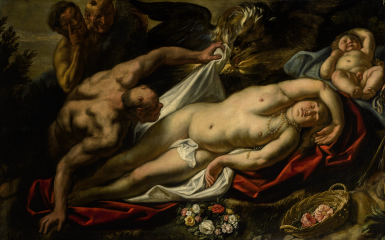
JACOB JORDAENS | THE SLEEPING ANTIOPE APPROACHED BY JUPITER
Auction Closed
January 30, 12:05 AM GMT
Estimate
200,000 - 300,000 USD
Lot Details
Description
JACOB JORDAENS
Antwerp 1593 - 1678
THE SLEEPING ANTIOPE APPROACHED BY JUPITER
signed and dated: J.Jord fecit 1660
oil on canvas
46 by 72½ in.; 116.8 by 184.2 cm.
Fernand Stuyck collection, Antwerp;
His sale, Brussels, Palais de Beaux Arts, 7-8 December 1960, lot 71.
R.-A. d’Hulst, Jordaens Drawings, London and New York 1974, vol. II, p. 345, under cat. no. A262 (as “painted with studio assistance”)
The subject of Jupiter and Antiope, which derives from a Roman myth describing the seduction of a beautiful sleeping girl by Jupiter in the form of a satyr, was very popular in the history of art before the seventeenth century. Common with Italian predecessors like Correggio and Titian, Jordaens has depicted the lascivious Jupiter as he lifts the veil to reveal the naked girl who has fallen asleep after the Maenad dances in honor of Bacchus.
Jordaens also drew inspiration from a masterful early painting by Rubens of Cimon and Iphegenia now in the Kunsthistorisches Museum in Vienna.1 Despite the difference in subject, the accidental poise of the sleeping woman, where she rests her arm above her head to reveal her nakedness, is common to both paintings. Moreover, Jordaens or a very gifted collaborator has added a still life of flowers in the immediate foreground of our painting, just as Rubens had enhanced his own composition with still-life elements by Frans Snyders.2
Jordaens had addressed the subject of Jupiter and Antiope once before, in a vertical canvas from 1650 now in the museum in Grenoble.3 He likewise studied the similar theme of a Sleeping Venus in a drawing in Lille, which is the preparatory study for a painting of circa 1645-1650 in Antwerp (fig. 1).4 Here we see a distinct relationship with our painting. The pose of the principle figure is nearly identical, with again her arm resting around her head, and a still life of flowers, likely the work of a gifted studio assistant, is common in the lower register of both paintings. In the Sleeping Venus, a standing Cupid looks over the goddess while other nymphs sleep alongside her. In our painting, Cupid is fast asleep in the upper right corner, while an eagle, carries a thunderbolt, both symbols of Jupiter and his role as king of the gods. Two satyrs look on, amused, although one chastises Jupiter with a swaying index finger.
1. For the painting in Vienna, see M. Jaffé, Catalogo Completo. Rubens, Milan, 1989, p. 231, no. 446 (as ca. 1617), and Rubens. The Power of Transformation, exhibition catalogue, Kunsthistorisches Museum, Vienna and Städl Museum, Frankfurt, 2018, cat. 110.
2. Following Jaffé (note 1), it is stated in the Vienna catalogue, 2018 (note 1) that Jan Brueghel contributed the still-life element with the monkey, while Jan Wildens was responsible for the landscape.
3. For the painting in Grenoble, see R.-A. d’Hulst, Jacob Jordaens, London, 1982, p. 222, fig. 194, and exhib. cat., Jordaens 1593-1678, Paris, Petit Palais, 2018, pp. 208-209, cat. no. III-11.
4. For the drawing in Lille, see d’Hulst, Literature 1974, pl 344, no. A262 and IV, fig. 278; for the painting in Antwerp see d’Hulst, 1982 (note 3), p. 224, fig. 192, and exhib cat. 2018 (note 3), pp. 202-203, cat. no. III-08.
